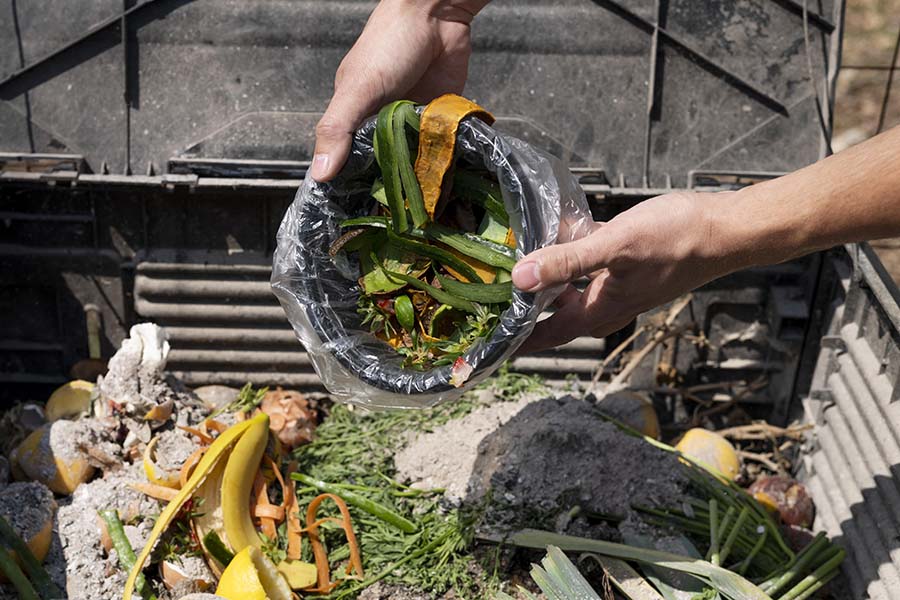Revolutionise Your Kitchen: Master Zero-Waste Cooking Magic!

Embracing a sustainable ethos, zero-waste cooking minimises food waste through comprehensive ingredient utilisation. This innovative culinary approach not only reduces our ecological footprint but also invites exploration of new flavors and textures, fostering creativity in the kitchen. Join us in this blog as we delve into the concept of zero-waste cooking, uncover its benefits, and offer practical tips to seamlessly incorporate it into your daily culinary routine.
What is zero-waste cooking?
Zero-waste cooking advocates for maximising ingredient usage, ensuring no part goes to waste. From root to stem, leaf to peel, every component is valued and utilized. Embracing this philosophy helps slash food waste, contributing to a more sustainable and responsible food system.
Delving into zero-waste cooking means discovering imaginative uses for every part of an ingredient, even those typically discarded. Carrot tops become a vibrant pesto, watermelon rinds transform into pickled snacks, and thinly sliced broccoli enhances stir-fries. By exploring these often overlooked elements, we not only minimise waste but also infuse depth and variety into our meals.
The benefits of zero-waste cooking
Adopting zero-waste cooking brings numerous advantages, benefiting both the environment and our personal well-being. Here are some compelling reasons to contemplate integrating this practice into your culinary repertoire:
Environmental impact
Reducing food waste is crucial for mitigating the environmental impact of our food consumption. When we throw away food, we waste valuable resources such as water, energy, and land used in its production, contributing to greenhouse gas emissions. We can minimise these environmental burdens and promote a more sustainable food system by utilising every part of our ingredients.
Engaging in zero-waste cooking enables us to make a substantial impact on shrinking our ecological footprint. Utilising every part of an ingredient diminishes landfill waste and lessens the resources required for additional food production. This translates to conservation of water, energy, and land—essential components for a sustainable future.
Cost-effective
We can stretch our food budget even further by using every part of the ingredients we purchase. Instead of buying additional ingredients, we can creatively repurpose the often-discarded parts into delicious meals, such as vegetable peels, stems, and leftovers. This saves money and encourages us to explore new culinary possibilities.
For example, instead of throwing away vegetable peels, we can use them to make flavorful vegetable stock when preparing a meal. Leftover roasted vegetables can be mashed and turned into a delicious sandwich spread or blended into a flavorful soup. By repurposing these ingredients, we reduce waste and create tasty and cost-effective meals.
Enhanced flavours and textures
Zero-waste cooking opens up a world of new flavours and textures that we may not have considered before. When we explore the often-overlooked parts of ingredients, such as stems, peels, and rinds, we discover unique taste profiles and textures that can elevate our dishes.
For instance, carrot tops can be transformed into a vibrant pesto that adds a fresh and herbaceous flavour to pasta or salads. Watermelon rinds, when pickled, provide a tangy and refreshing snack. Broccoli stems, when thinly sliced and used in stir-fries, offer a crisp and crunchy texture. By incorporating these often-discarded parts into our meals, we reduce waste and enhance the overall taste and texture experience.
Boosts creativity
Embracing zero-waste cooking provides an opportunity to unleash your creativity in the kitchen. Instead of following traditional recipes, you can experiment with using different parts of the ingredients and develop unique dishes that reflect your personal taste and style. It’s a chance to think outside the box and utilise ingredients to their full potential.
For example, vegetable scraps can infuse oils and vinegar, creating unique flavour profiles. Leftover bread can be transformed into homemade breadcrumbs or croutons. By getting creative with these often-overlooked parts, you reduce waste and add your personal touch to your culinary creations.
Practical tips for zero-waste cooking
Now that we understand the concept and benefits of zero-waste cooking let’s explore some practical tips to help you incorporate this sustainable practice into your everyday cooking:
Plan your meals
Planning your meals in advance is vital to minimising food waste. Take inventory of the ingredients you already have and plan your meals accordingly. This way, you can ensure that all the components of the ingredients will be utilised, leaving no room for waste.
Create a weekly meal plan and make a shopping list based on the ingredients you already have. This will help you avoid buying unnecessary items and ensure you use all the ingredients in your pantry and refrigerator. Additionally, consider batch cooking and meal prepping to make the most out of your ingredients and minimise waste.
Get creative with vegetable scraps.
Vegetable scraps, such as carrot tops, onion skins, and herb stems, are often discarded. Still, they can be transformed into flavorful additions to your dishes. Make a nutrient-rich vegetable stock by simmering these scraps with water, or use them to infuse oils and vinegar for added depth of flavour.
Instead of throwing away vegetable scraps, consider using them to enhance the taste of your meals. Vegetable scraps like onion skins and herb stems can make a flavorful and aromatic vegetable stock, serving as a base for soups, stews, and sauces. You can also infuse oils and vinegar with vegetable scraps to create unique and flavorful dressings or marinades.
Repurpose leftovers
Leftovers are a prime opportunity to exercise zero-waste cooking. Instead of throwing them away, try incorporating them into new dishes. For example, yesterday’s roasted vegetables can be mashed and turned into a delicious spread for sandwiches or blended into a flavorful soup.
Leftover ingredients and meals can be transformed into new and exciting dishes. For instance, leftover rice can make fried rice or become a comforting rice pudding. Use leftover roasted vegetables to create a hearty frittata, or add them to a salad for a nutritious meal. By repurposing leftovers, you reduce waste and save time and effort in preparing new meals.
Preserve and pickle
Preserving and pickling are great ways to extend the shelf life of fruits and vegetables. Take advantage of seasonal produce and preserve them in vinegar or salt brine jars. This reduces waste and adds a delightful tang to your meals.
Preserving and pickling allow you to enjoy seasonal produce long after its peak. Preserving fruits and vegetables in jars with vinegar or salt brine can extend their shelf life and add unique flavours to your meals. Pickled cucumbers, for example, make a crunchy and tangy addition to sandwiches and salads. You can also preserve seasonal fruits to enjoy them as jams or compotes throughout the year.
Embrace nose-to-tail cooking
Nose-to-tail cooking, traditionally associated with meat, can also be applied to plant-based ingredients. For instance, beet greens can be sautéed and enjoyed as a side dish, and broccoli stalks can be grated to make a crunchy slaw. Don’t limit yourself to using only the edible parts; give the whole ingredient a chance to shine.
Regarding plant-based ingredients, embracing nose-to-tail cooking means using every part of the plant, from root to stem. Beet greens, for example, can be sautéed with garlic and olive oil, resulting in a nutritious and flavorful side dish. Broccoli stalks, often discarded, can be grated and used as a base for a crunchy and refreshing slaw. By exploring the full potential of each ingredient, you reduce waste and discover new and exciting ways to enjoy them.
Compost
Despite our best efforts, there may still be some food waste that cannot be utilised. In such cases, composting is a sustainable solution. Set up a compost bin in your backyard, or check if your local community has composting facilities available. By composting, you can turn food waste into nutrient-rich soil that can be used to nourish your garden.
Composting is an excellent way to reduce waste and create nutrient-rich soil for your garden. Set up a compost bin in your backyard and add food scraps, yard waste, and other organic materials. Make sure to turn the compost regularly to promote decomposition. If you need more space for a backyard compost bin, check if your local community has composting facilities. By composting, you not only divert waste from landfills but also contribute to the circularity of resources by returning nutrients to the soil.
Conclusion
Zero-waste cooking is a mindful and sustainable approach that allows us to reduce food waste while embracing culinary creativity. We can significantly reduce our ecological footprint and contribute to a more sustainable food system by utilising every part of the ingredients we purchase. So, let’s embark on this journey together, one ingredient at a time, and savour the flavours and benefits of zero-waste cooking.
Check out our other related posts if you enjoyed this one.
- Jet-Setter Must-Haves: Fashionable Travel Essentials!
- Unlock Wealth Secrets: Rich Dad Poor Dad Reveals All!
- Unleash Your Earning Potential: Mastering the Gig Economy Game!
- Unlock Your Peak Performance: Fast This Way with Dave Asprey!
- Wild Adventures and Hilarious Mishaps: Bill Bryson’s Appalachian Trail Tale!
- Mastering AutoML: Perks, Uses & Hurdles Uncovered
- Love Unveiled: Cracking the Code of Relationships with John Gray!
- Unlocking Forever: Master the Secrets to Relationship Bliss!
- Unwrap the Magic: 2023’s Hottest Holiday Décor Trends Revealed!
- The Ultimate Guide to a F*ck-Less, Fulfilling Life! – Mark Manson
If you enjoyed this blog post, subscribe for updates and stay tuned for our latest insights.
Help your friends and colleagues stay informed about the newest insights on business, marketing, finance, lifestyle, and society by sharing our blog content through Facebook, Twitter, Pinterest, LinkedIn, email, or WhatsApp links below. We can create a knowledge-sharing community and empower one another to accomplish and experience our objectives.
FAQ
What is zero-waste cooking?
Zero-waste cooking is a philosophy that aims to minimise food waste by utilising every part of ingredients, from root to stem, leaf to peel.
What are the benefits of zero-waste cooking?
Embracing zero-waste cooking has several benefits, including reducing environmental impact, being cost-effective, enhancing flavours and textures, and boosting creativity in the kitchen.
How can I incorporate zero-waste cooking into my everyday cooking?
You can incorporate zero-waste cooking into your everyday cooking by planning your meals, getting creative with vegetable scraps, repurposing leftovers, preserving and pickling, embracing nose-to-tail cooking, and composting.
How does zero-waste cooking contribute to a more sustainable food system?
Zero-waste cooking helps reduce food waste in landfills, minimising water, energy, and land use in food production. It promotes a more sustainable future by reducing waste and preserving the environment.
Credits
Featured image by Freepik.









